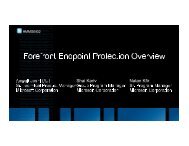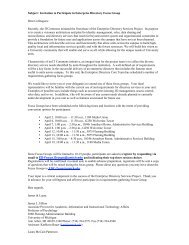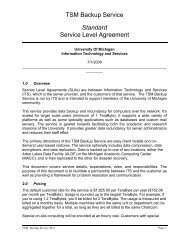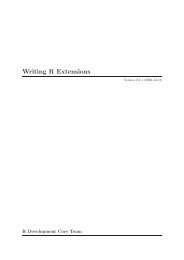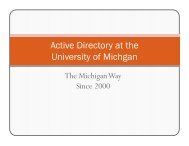What documentation exists for R?
What documentation exists for R?
What documentation exists for R?
Create successful ePaper yourself
Turn your PDF publications into a flip-book with our unique Google optimized e-Paper software.
Chapter 7: R Miscellanea 82<br />
(Because the word “Trellis” has been claimed as a trademark we do not use it in R. The<br />
name “lattice” has been chosen <strong>for</strong> the R equivalent.)<br />
7.12 <strong>What</strong> are the enclosing and parent environments?<br />
Inside a function you may want to access variables in two additional environments: the one<br />
that the function was defined in (“enclosing”), and the one it was invoked in (“parent”).<br />
If you create a function at the command line or load it in a package its enclosing environment<br />
is the global workspace. If you define a function f() inside another function g()<br />
its enclosing environment is the environment inside g(). The enclosing environment <strong>for</strong> a<br />
function is fixed when the function is created. You can find out the enclosing environment<br />
<strong>for</strong> a function f() using environment(f).<br />
The “parent” environment, on the other hand, is defined when you invoke a function.<br />
If you invoke lm() at the command line its parent environment is the global workspace, if<br />
you invoke it inside a function f() then its parent environment is the environment inside<br />
f(). You can find out the parent environment <strong>for</strong> an invocation of a function by using<br />
parent.frame() or sys.frame(sys.parent()).<br />
So <strong>for</strong> most user-visible functions the enclosing environment will be the global workspace,<br />
since that is where most functions are defined. The parent environment will be wherever<br />
the function happens to be called from. If a function f() is defined inside another function<br />
g() it will probably be used inside g() as well, so its parent environment and enclosing<br />
environment will probably be the same.<br />
Parent environments are important because things like model <strong>for</strong>mulas need to be evaluated<br />
in the environment the function was called from, since that’s where all the variables<br />
will be available. This relies on the parent environment being potentially different with<br />
each invocation.<br />
Enclosing environments are important because a function can use variables in the enclosing<br />
environment to share in<strong>for</strong>mation with other functions or with other invocations of<br />
itself (see the section on lexical scoping). This relies on the enclosing environment being<br />
the same each time the function is invoked. (In C this would be done with static variables.)<br />
Scoping is hard. Looking at examples helps. It is particularly instructive to look at<br />
examples that work differently in R and S and try to see why they differ. One way to describe<br />
the scoping differences between R and S is to say that in S the enclosing environment is<br />
always the global workspace, but in R the enclosing environment is wherever the function<br />
was created.<br />
7.13 How can I substitute into a plot label?<br />
Often, it is desired to use the value of an R object in a plot label, e.g., a title. This is easily<br />
accomplished using paste() if the label is a simple character string, but not always obvious<br />
in case the label is an expression (<strong>for</strong> refined mathematical annotation). In such a case,<br />
either use parse() on your pasted character string or use substitute() on an expression.<br />
For example, if ahat is an estimator of your parameter a of interest, use<br />
title(substitute(hat(a) == ahat, list(ahat = ahat)))<br />
(note that it is ‘==’ and not ‘=’). Sometimes bquote() gives a more compact <strong>for</strong>m, e.g.,



